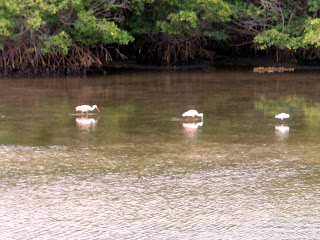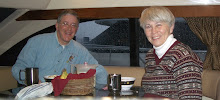 The sun was bright this morning as we pulled anchor next to a large white sailboat who shared our anchorage in Manatee Pocket. Our first task of the day was to fill up with 200 gallons of diesel fuel at the Pirates Cove marina where we met a lady with family in Durham. She commented that the river there reminded her of Eastern NC waterways (however, there was not a shrimp boat in site!) Then we began retracting our path back to the ICW.
The sun was bright this morning as we pulled anchor next to a large white sailboat who shared our anchorage in Manatee Pocket. Our first task of the day was to fill up with 200 gallons of diesel fuel at the Pirates Cove marina where we met a lady with family in Durham. She commented that the river there reminded her of Eastern NC waterways (however, there was not a shrimp boat in site!) Then we began retracting our path back to the ICW.
Today the ICW runs along in Indian River. Indian River is a couple of miles wide but shallow, only about 8 to 10  feet in the channel. The broad water is dappled with small islands and sand bars. It is a delightful place for water birds and we were happily surprised to see our first pink flamingos dining along the shore. There was also a tall dignified blue Heron on the shore.
feet in the channel. The broad water is dappled with small islands and sand bars. It is a delightful place for water birds and we were happily surprised to see our first pink flamingos dining along the shore. There was also a tall dignified blue Heron on the shore.
Our big outing for the day was a visit to Fort Pierce. Tom called the US Navy SEALs Museum and got directions for how to find the place by boat. We crossed un der the Fort Pierce bridge and turned up a narrow channel, anchoring where we could dinghy the bikes to a little sandy spot on the shore. The beach was right by Highway A1A and
der the Fort Pierce bridge and turned up a narrow channel, anchoring where we could dinghy the bikes to a little sandy spot on the shore. The beach was right by Highway A1A and there was a wonderful paved bicycle trail that covered the mile and a half ride to the museum. The museum sits on ground considered the birthplace of the Navy Frogmen and brought to life a segment of miliary history full of rigor, challenge and heroism. The museum was dedicated in 1985 and has had a stream of artifacts
there was a wonderful paved bicycle trail that covered the mile and a half ride to the museum. The museum sits on ground considered the birthplace of the Navy Frogmen and brought to life a segment of miliary history full of rigor, challenge and heroism. The museum was dedicated in 1985 and has had a stream of artifacts  collected here.
collected here.
On the grounds we saw a Huey helicopter and two desert patrol vehicles (DPV) which had been used by Navy SEALS in military operations in Kuwait, Afghanistan and Iraq. The DPVs could be dropped by parachute, were heavily armed and could reach speeds of 80 mph. There were also unique underwater vehicles, some that were filled with water so that the occupants wore SCUBA gear while riding.
Inside the museum, the Navy history explained discovering the need for underwater demolition after the WWII  battle of Tarawa. Many US Marines lives were lost because the landing crafts were not able to reach the beaches. After that underwater demolition teams performed reconnaissance for every beach invasion clearing the shores of defenses. They had a map of the Omaha beach in France show where each of the barriers were.
battle of Tarawa. Many US Marines lives were lost because the landing crafts were not able to reach the beaches. After that underwater demolition teams performed reconnaissance for every beach invasion clearing the shores of defenses. They had a map of the Omaha beach in France show where each of the barriers were.
There were interesting life stories, like young Draper Kauffman who graduated from the Naval Academy in 1933 but was denied his commission because of poor  eyesight. He went to France and volunteered as an ambulance driver until the French Army collapsed; and then enlisted in the UK Naval Reserves where he learned about how to dismantle unexploded bombs. When he returned to Washington, DC in 1941 he gained his commission with the US Navy, and was called on to formulate the training and operations of a new underwater demolition team. He chose Fort Pierce, Fl as the training ground, and from 1943 to 1946 thousands of brave volunteers were trained as members of the Navy Combat Demolition Units. They were the first
eyesight. He went to France and volunteered as an ambulance driver until the French Army collapsed; and then enlisted in the UK Naval Reserves where he learned about how to dismantle unexploded bombs. When he returned to Washington, DC in 1941 he gained his commission with the US Navy, and was called on to formulate the training and operations of a new underwater demolition team. He chose Fort Pierce, Fl as the training ground, and from 1943 to 1946 thousands of brave volunteers were trained as members of the Navy Combat Demolition Units. They were the first on the beach on D Day in Normandy in 1944, and two weeks later Kauffman led the 100 man underwater demolition team (UDT) in the invasion of Saipan in the Pacific. The UDT's removed 600 beach obstacles in the battle for Guam making the way for 50,000 US troops and the securing of a firm supply line for the US troops in the Pacific. The museum included a small wooden sign said to have been left that day as a prank on the beach inviting the Marines to the USO!
on the beach on D Day in Normandy in 1944, and two weeks later Kauffman led the 100 man underwater demolition team (UDT) in the invasion of Saipan in the Pacific. The UDT's removed 600 beach obstacles in the battle for Guam making the way for 50,000 US troops and the securing of a firm supply line for the US troops in the Pacific. The museum included a small wooden sign said to have been left that day as a prank on the beach inviting the Marines to the USO!
Draper Kauffman served America well; later becoming an Admiral as well as serving as the Superintendent of the Naval Academy.
The UDTs became the Sea, air and Land Teams (SEALs) in Vietnam where they were charged with intelligence gathering in the jungles. There was a video showing some of the SEALs current training program including swimming with their hands and feet tied – pretty amazing. 
Our return to the boat was quick and we were back underway. In the afternoon we passed Orchid Island with its elegant homes on the water front; and we saw dolphins playing in the wake of the boat in front of us. They seemed to be leaping over the boat  wake like children playing in the surf on the sea shore.
wake like children playing in the surf on the sea shore. 
We are learning the early summer Florida weather pattern.  The late afternoon has brought storm clouds again and we anchored just minutes before the bottom dropped out. We could see the rain moving across the water and the lightening in the distance.
The late afternoon has brought storm clouds again and we anchored just minutes before the bottom dropped out. We could see the rain moving across the water and the lightening in the distance.














No comments:
Post a Comment